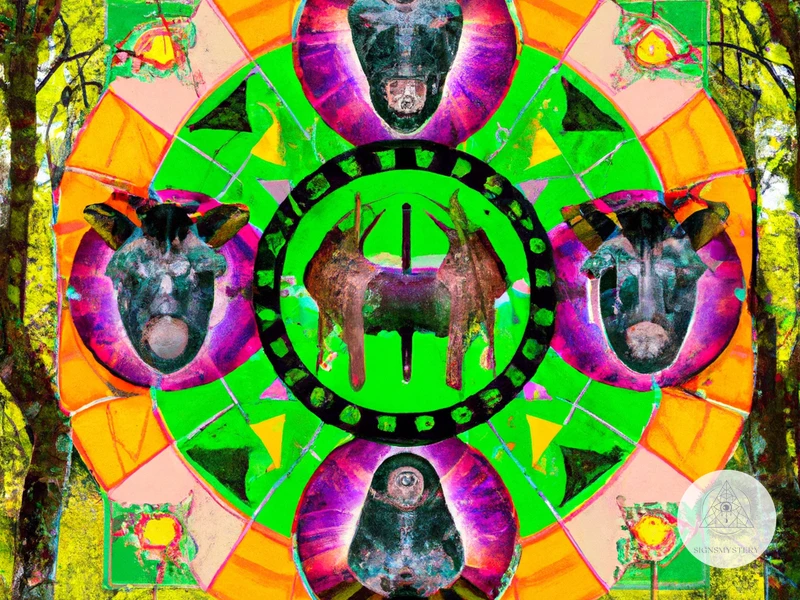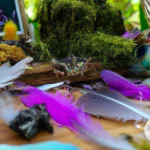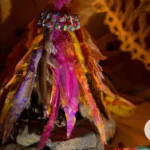Exploring the depths of spirituality has always been a fascination of humans, and one of the most ancient ways of doing so is through shamanism. While traditional shamanism has roots in the indigenous cultures of various regions across the world, the emergence of neo-shamanism has grown in the last few decades. Neo-shamanism is a modern take on this ancient spiritual practice that incorporates various elements of technology, new age practices, and ceremonies. The concept of neo-shamanism can be perplexing for many, but this guide aims to provide you a detailed understanding of its history, principles, and criticisms, along with ways you can practice it in your spiritual journey.
What is Neo-Shamanism?

Neo-Shamanism is a modern spiritual practice that has gained popularity in recent years. Its roots lie in traditional Shamanism practices of indigenous cultures, but it has evolved with the times. Neo-Shamanism places emphasis on personal experience and direct communication with spirit guides, animals, and other entities. Neo-Shamans believe in a holistic approach to healing the mind, body, and spirit. The basic principles of this practice include connecting with nature, exploring altered states of consciousness, and seeking answers within oneself. While Neo-Shamanism does utilize traditional techniques, it also incorporates new tools such as technology and psychedelic plants to enhance the experience. The history, principles, and beliefs of Neo-Shamanism are essential to understanding the importance of its practices for modern spiritual seekers. To learn more about the evolution of Neo-Shamanism, visit /neo-shamanism-evolution/ or explore other related articles.
History of Neo-Shamanism
Neo-Shamanism is a modern take on traditional shamanic practices that have been present in cultures for centuries. It originated in the 1960s as a counter-cultural movement in response to the mainstream culture’s lack of spirituality. It was also influenced by anthropologist Michael Harner’s concept of core shamanism, which involved the use of shamanic techniques from various cultures to access the spiritual dimensions of reality.
In the 1980s, neo-shamanism gained popularity in the west as people began to explore alternative spiritual practices. It was also influenced by new age beliefs and practices that were gaining popularity at the time.
While neo-shamanism draws inspiration from traditional shamanic practices, it is distinguished by its modern approach to spirituality. It incorporates modern technology, such as the use of electronic drumming and guided meditation, to facilitate shamanic journeys.
Today, neo-shamanism continues to evolve and adapt to the changing needs and interests of practitioners. It remains a popular form of spiritual practice, offering individuals an opportunity to connect with their inner selves and the world around them through shamanic techniques.
Further Reading: Neo-Shamanism Principles and Beliefs, Traditional vs. Neo-Shamanism, Shamanic Journeying in Neo-Shamanism, Plants and Psychedelics in Neo-Shamanic Practice, Neo-Shamanic Healing, How to Safely Explore Neo-Shamanism as a Beginner, Famous Neo-Shamanic Practitioners, Neo-Shamanism’s Impact on Modern Spirituality and Well-Being.
Basic Principles of Neo-Shamanism
Basic Principles of Neo-Shamanism can be traced back to the traditional practices of indigenous cultures. It serves as a way to connect with nature and the spiritual world. Unlike the traditional form, Neo-Shamanism does not involve specific rituals or ceremonies which are native to particular cultures. The main principles of Neo-Shamanism have been defined by Michael Harner and are based on his research on indigenous shamanism. Some of the essential principles of Neo-Shamanism are:
1. Direct Revelation: In Neo-Shamanism, direct revelation is vital. It is believed that spirits or guides can directly communicate with individuals. This communication can happen through visions, dreams, or a shamanic journey. Direct revelation can provide insight into oneself, nature, and the spiritual world.
2. The Use of Tools: Neo-Shamanism practitioners use different tools to connect with Spirits. Some of the commonly used tools are drums, rattles, feathers, and crystals. These tools are believed to assist in moving a person into a shamanic state of consciousness and enhancing the connection with spirits.
3. Healing: Healing is an essential principle of Neo-Shamanism. Shamans use their connection with spirits to heal themselves and others. Healing can occur at different levels, including physical, emotional, and spiritual.
4. Balance: The principle of balance is also significant in Neo-Shamanism. It emphasizes the balance between the physical and spiritual worlds’ energies to ensure the well-being of an individual and the community. Neo-Shamanism teaches that everything in the world is interconnected and that one needs to maintain harmony and balance to live a fulfilling life.
5. Spirit Guides: Neo-Shamanism practitioners believe in the existence of spirit guides. These guides can be from different realms and can assist individuals in their shamanic journey. The role of spirit guides is to provide guidance, protection, and support.
The Basic Principles of Neo-Shamanism incorporate elements from traditional shamanism and modern practices. Direct revelation, the use of tools, healing, balance, and spirit guides are some of the essential principles that form the foundation of Neo-Shamanism. These basic principles serve as a guide for practitioners to connect with nature, explore the spiritual world, and seek answers to their questions.
How is Neo-Shamanism Different?
Neo-Shamanism differs from traditional shamanism in several ways. One important factor is the role of technology in modern-day neo-shamanism. With the advent of virtual reality and other advancements, some neo-shamans are incorporating technology into their practice. Additionally, the influence of New Age practices has contributed to the development of neo-shamanism, leading to a more personalized and eclectic approach to spirituality. While traditional shamanism is deeply rooted in specific cultural practices and traditions, neo-shamanism is more individualistic and adaptable. Despite criticisms of cultural appropriation and lack of traditional training, the growing popularity of neo-shamanism shows that many are finding value in this modern interpretation of an ancient spiritual practice.
The Role of Technology
Technology has played an important role in the evolution of Neo-Shamanism. With the rise of the internet and social media, individuals have been able to connect with like-minded individuals and access information about different shamanic practices around the world.
One of the most significant ways that technology has impacted Neo-Shamanism is through the use of online shamanic journeys and virtual ceremonies. These virtual gatherings allow individuals from different parts of the world to come together and participate in healing ceremonies or shamanic journeys in real-time.
However, some Neo-Shamans are critical of the use of technology in these practices, arguing that it can create a disconnection from nature and the physical world. They believe that the use of technology in shamanic practices is a form of cultural appropriation and want to maintain the traditional and authentic practices of shamanism.
On the other hand, proponents of the use of technology in Neo-Shamanism argue that technology can be used as a tool to deepen our connection to nature and the spiritual realm. For example, virtual reality technology can be used to create immersive environments for shamanic journeys, allowing individuals to connect with nature even in urban areas.
The role of technology in Neo-Shamanism is a topic of debate within the community. While some Neo-Shamans are wary of the impact of technology on traditional practices, others see it as a way to expand and evolve shamanic practices for the modern world.
The Influence of New Age Practices
The influence of New Age practices on Neo-Shamanism cannot be ignored. New Age spirituality has drawn from a variety of belief systems, including traditional shamanism, and has had a significant impact on modern spiritual practices. Here are some of the ways that New Age practices have influenced Neo-Shamanism:
| New Age Practices | Influence on Neo-Shamanism |
|---|---|
| Crystal Healing | Neo-Shamans have incorporated the use of crystals into their healing practices. |
| Reiki | Many Neo-Shamans have adopted Reiki as a form of energy healing. |
| Meditation | Meditation is a common practice in both New Age spirituality and Neo-Shamanism and is often used to induce trance states. |
| Astral Travel | Some Neo-Shamans incorporate the practice of astral travel into their shamanic journeys. |
| Angel Readings | Some Neo-Shamans offer angel readings as a form of divination. |
While some criticize the influence of New Age practices on Neo-Shamanism, it has allowed for modern practitioners to adapt and evolve traditional shamanic practices to fit their personal beliefs and experiences. It has also opened up the practice to a wider audience who may not have been interested in traditional shamanism. The incorporation of New Age practices has contributed to the diversity and growth of Neo-Shamanism.
Practicing Neo-Shamanism

Practicing Neo-Shamanism involves a variety of techniques and rituals that allow for a deeper connection to the spiritual world. Shamanic Journeys and Trance Work use drumming and meditation to enter altered states of consciousness and communicate with spirits and guides. Learning how to journey is an essential skill for neo-shamans. The Use of Psychedelics can also be a part of neo-shamanic practice, although it is not necessary. Substances like ayahuasca, psilocybin, and peyote are used in traditional shamanic practices and have gained popularity among modern neo-shamans as well. Healing and Ceremony are also important components of neo-shamanism. This includes performing energy work on oneself or others, as well as holding ceremonies for important life events. Depending on the individual practitioner, neo-shamanism can involve a combination of these practices or focus more heavily on one area.
Shamanic Journeys and Trance Work
Shamanic journeys are an essential part of Neo-Shamanism, providing a way to connect with spirits and receive guidance. During a shamanic journey, a person enters into a trance state, usually through drumming or rattling. Once in this state, the shamanic practitioner can access the spiritual world and communicate with divine entities, power animals, and ancestors.
The journey may take the form of a specific quest, such as finding a missing object or receiving healing guidance. Alternatively, it may be more open-ended, allowing the shamanic practitioner to explore the spiritual realm and gain insights into themselves and the world around them.
Trance work is the process of intentionally entering into a trance state, either for shamanic journeys or other spiritual practices. Neo-Shamanism places a significant emphasis on the importance of trance work as a means of accessing spiritual knowledge and growth.
Trance work can also be used for healing and self-exploration. During a trance state, a person can access deeper parts of the psyche and bring to light any unresolved emotions or traumas that need to be addressed.
It is important to note that shamanic journeys and trance work should only be performed by trained practitioners who understand how to enter and exit a trance state safely. Without proper guidance, there is a risk of becoming stuck in a trance state or experiencing negative spiritual experiences.
Shamanic journeys and trance work are integral parts of Neo-Shamanism, allowing practitioners to connect with the spiritual realm and gain insight and healing. Proper training and guidance are crucial for conducting these practices safely and effectively.
The Use of Psychedelics
The use of psychedelics has been a controversial topic in Neo-Shamanism for several reasons. Some practitioners believe that the use of these substances can enhance spiritual experiences and aid in the discovery of unconscious material. However, others argue that it goes against the traditional and natural methods of Shamanism.
Psychedelics are substances that can alter a person’s perception, mood, and consciousness. They include substances like LSD, psilocybin mushrooms, and ayahuasca. In Neo-Shamanism, the use of psychedelics is often referred to as “plant medicine” and is seen as a way to connect with the spirit world.
One of the main arguments against the use of psychedelics in Neo-Shamanism is that it can be dangerous and even life-threatening. These substances can cause unpredictable reactions, and a bad trip can be emotionally traumatising. Many practitioners suggest only working with psychedelics in a controlled and supervised environment.
Another argument against the use of psychedelics is that it goes against the natural methods of Shamanism. Traditional Shamans often used natural tools like drumming, dancing, and meditation to reach a trance-like state. The use of plant medicine can be seen as a shortcut and therefore, less authentic.
On the other hand, many Neo-Shamans argue that psychedelics can be a powerful tool for spiritual growth and can provide a profound new perspective on life. They argue that when used correctly and respectfully, psychedelics can lead to life-changing experiences that can positively impact a person’s well-being.
The use of psychedelics in Neo-Shamanism is a complex issue that involves personal beliefs and values. While some practitioners argue that psychedelics can enhance spiritual experiences, others believe that traditional natural methods should be the only way to reach an altered state of consciousness. Regardless of the stance, it is essential to approach the use of plant medicine with caution and respect.
Healing and Ceremony
Healing and ceremony are crucial aspects of Neo-Shamanism. Shamans use various techniques to heal people’s body, mind, and
Subscribe to Our Newsletter
Sign up to receive the latest news and updates.
One of the primary methods of healing in Neo-Shamanism is the ‘soul retrieval ceremony.’ It involves a shaman entering into a trance state and traveling to the spiritual realm to retrieve a person’s lost soul fragments. It is believed that loss of soul fragments can lead to depression, anxiety, and other mental disorders. The shaman brings back those fragments and integrates them back into the person’s being to restore their spiritual wholeness.
Another method that shamans use for physical healing is the ‘extraction ceremony.’ In this method, the shaman removes negative energies or entities from the patient’s body. Shamans use various tools, like feathers or crystals, to remove the negative energy. They believe that removing the negative energy can help the person heal physically.
Apart from these, shamans also use other spiritual practices such as chanting, dancing, and drumming to heal individuals. They believe that these practices can reconnect people with their spiritual essence and help them heal.
Neo-Shamanism also involves various ceremonies, which are designed to celebrate the cycles of nature and to honor the spirits that govern them. One such ceremony is the ‘sweat lodge ceremony.’ In this ceremony, participants sit inside a sweat lodge, which is a dome-shaped structure, and experience intense heat generated by heated stones. The ceremony is believed to purify the participants both physically and spiritually.
Healing and ceremony are integral parts of Neo-Shamanism. It emphasizes the importance of spiritual healing and connection with nature. Through various techniques and ceremonies, Neo-Shamanism aims to restore spiritual balance and promote well-being.
Criticisms of Neo-Shamanism
As with any spiritual practice that involves cultural elements, Neo-Shamanism has not been immune to criticisms. One of the main criticisms revolves around cultural appropriation, with some arguing that non-indigenous individuals are taking and misusing elements of indigenous cultures without proper understanding or respect for their significance. Another criticism is the lack of traditional training, with some skeptics arguing that too many people are claiming to be “shamans” without proper apprenticeships or lineage. While these criticisms raise valid points, it’s important to note that Neo-Shamanism, when practiced with respect and understanding, can offer a valuable and transformative spiritual practice for individuals seeking connection with the natural world.
Cultural Appropriation
Neo-Shamanism has been criticized by some for cultural appropriation. This is the act of taking elements of a culture that is not your own without proper understanding or respect for their significance and history. In the case of Neo-Shamanism, this often involves misrepresenting or oversimplifying indigenous shamanic practices, beliefs, and traditions.
Critics argue that Neo-Shamanism trivializes and commodifies indigenous cultures, reducing them to mere accessories or entertainment for non-indigenous people. They claim that it perpetuates harmful stereotypes and erases the lived experiences of indigenous peoples who have been suppressed and oppressed for centuries.
Some Neo-Shamanic practitioners counter these criticisms by arguing that their practices are inclusive and respectful of diverse cultures. They claim that they have adapted indigenous shamanic practices to modern times and contexts, transforming them into a universal spirituality that can be embraced by all.
However, critics argue that this approach ignores the power dynamics and historical context of colonialism, exploitation, and cultural genocide that have defined the relationship between indigenous and non-indigenous peoples. They argue that true respect for indigenous cultures entails listening to and learning from them, rather than appropriating and colonizing their spiritual practices.
In short, cultural appropriation is a complex issue that demands critical reflection and sensitivity from Neo-Shamanic practitioners and enthusiasts. While it is important to honor the wisdom and teachings of indigenous shamanic traditions, it is equally important to recognize the historical and structural inequalities that shape our understanding and practice of spirituality.
Lack of Traditional Training
One of the main criticisms of Neo-Shamanism is the “Lack of Traditional Training.” Traditional shamans typically undergo many years of intensive training with a master shaman before they can practice on their own. This is a stark contrast to Neo-Shamanism, where many practitioners just read a few books or attend a weekend workshop to gain knowledge.
So, why is the lack of traditional training a problem?
First of all, it can be argued that without proper training, Neo-Shamans may not be equipped to handle the complex spiritual and emotional needs of their clients. Traditional shamans undergo rigorous training that prepares them for a wide range of situations. They learn how to connect with spirits, interpret signs and symbols, and facilitate healing. Without this training, Neo-Shamans may not be as effective in their practice.
Another issue with the lack of traditional training is the potential for cultural appropriation. Traditional shamans come from specific cultural contexts, and their practices are deeply tied to their cultural heritage. In contrast, Neo-Shamans may pick and choose various practices from different cultures without fully understanding their cultural significance. This can be seen as disrespectful and can also perpetuate harmful stereotypes about certain cultures.
But is traditional training really necessary?
Some Neo-Shamans argue that traditional training is not necessary in order to be an effective shaman. They may claim that they have their own unique gifts and talents that allow them to connect with the spiritual realm. While this may be true in some cases, it is important to acknowledge that traditional training has been used for centuries for a reason. It provides a solid foundation for practicing shamanism and ensures that the practitioner is well-prepared to handle any situation that may arise.
The lack of traditional training in Neo-Shamanism is a valid criticism. Without proper training, Neo-Shamans may not be equipped to handle the complexities of shamanic practice. Additionally, the lack of traditional training can lead to cultural appropriation and perpetuate harmful stereotypes. While some may argue that traditional training is not necessary, it is important to acknowledge the value of centuries-old practices that have stood the test of time.
Conclusion
In conclusion, Neo-Shamanism is a modern spiritual practice that draws on ancient shamanic traditions from around the world. It emphasizes personal empowerment, connection with nature, and spiritual growth through trance work, ceremony, and healing.
Although it has been criticized for cultural appropriation and lack of traditional training, Neo-Shamanism is becoming increasingly popular as people seek deeper meaning and connection in their lives.
One of the key strengths of Neo-Shamanism is its flexibility and adaptability. Practitioners are free to incorporate a wide range of techniques and practices from different cultures and traditions, including the use of psychedelics and technology.
However, it is important for Neo-Shamanism to be practiced with respect, integrity, and awareness of cultural appropriation. Practitioners should also seek out appropriate training and guidance from experienced teachers and mentors.
Overall, Neo-Shamanism offers a powerful and transformative path for those seeking to connect with their inner selves, the natural world, and the spiritual realms. With its focus on personal empowerment, healing, and transformation, it has the potential to help people live more meaningful and fulfilling lives.
Table:
| Pros of Neo-Shamanism | Cons of Neo-Shamanism |
|————————–|—————————|
| Offers personal empowerment | Criticized for cultural appropriation |
| Encourages connection with nature | Lack of traditional training |
| Emphasizes spiritual growth | Can be misunderstood or misrepresented |
| Flexibility and adaptability | May not be suitable for everyone |
List:
Pros of Neo-Shamanism:
– Offers personal empowerment
– Encourages connection with nature
– Emphasizes spiritual growth
– Flexibility and adaptability
Cons of Neo-Shamanism:
– Criticized for cultural appropriation
– Lack of traditional training
– Can be misunderstood or misrepresented
– May not be suitable for everyone
Frequently Asked Questions
What is the origin of Neo-Shamanism?
Neo-Shamanism emerged in the West during the mid-20th century, drawing upon the practices of indigenous shamanic cultures around the world.
What are the basic principles of Neo-Shamanism?
The basic principles of Neo-Shamanism include a belief in the interconnectedness of all things, the importance of direct experience, and the use of various techniques such as trance work, ceremony, and healing practices.
How is Neo-Shamanism different from traditional shamanism?
Neo-Shamanism often incorporates contemporary beliefs and practices, such as the use of technology, and is pursued in the absence of a traditional lineage or cultural context.
What role does technology play in Neo-Shamanism?
Advancements in technology have led to the development of unique neo-shamanic practices, such as the use of biofeedback devices and virtual reality headsets to induce altered states of consciousness.
What is a shamanic journey?
A shamanic journey is a meditative practice that involves entering a trance state in order to commune with spiritual entities or access hidden knowledge. This is often done through visualization or the use of repetitive drumming.
What is the use of psychedelics in Neo-Shamanism?
Psychedelics are sometimes used in Neo-Shamanic contexts as a tool to induce altered states of consciousness and facilitate spiritual experiences.
What are some common healing practices in Neo-Shamanism?
Common healing practices in Neo-Shamanism include energy work, herbalism, sound healing, and the use of ritual and ceremony to promote spiritual and physical wellbeing.
What is cultural appropriation in the context of Neo-Shamanism?
Cultural appropriation refers to the adoption of practices or symbols from a culture to which one does not genuinely belong, often without proper understanding or respect for their cultural significance. Some criticize Neo-Shamanism for appropriating indigenous traditions without proper context or respect.
What is the lack of traditional training in Neo-Shamanism?
Lack of traditional training refers to the fact that many Neo-Shamans engage in practices without the cultural or ancestral context that traditionally underpins shamanic practices in indigenous cultures.
What are some criticisms of Neo-Shamanism?
Some criticisms of Neo-Shamanism include accusations of cultural appropriation, lack of traditional training, and a tendency to commodify or trivialize sacred practices.










